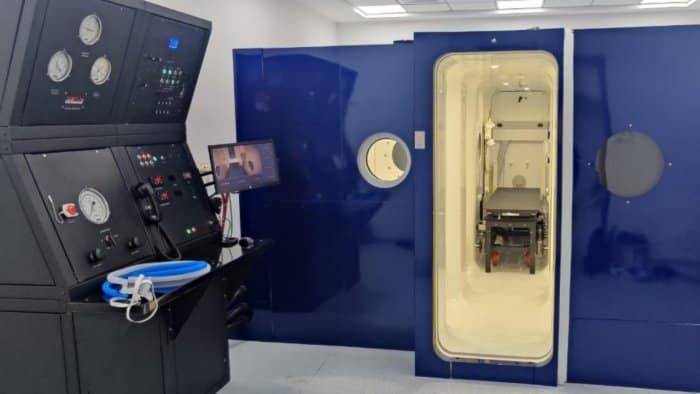
Photo Credit: Special arrangement
In a first for a government medical centre in Karnataka, Victoria Hospital got a hyperbaric oxygen therapy unit on Tuesday. The unit has been set up at a cost of Rs 3.5 crore.
Hyperbaric oxygen therapy is a well-established treatment for decompression sickness. Other conditions treated with hyperbaric oxygen therapy include serious infections, bubbles of air in the blood vessels and wounds that may not heal as a result of diabetes or radiation injury.
Common patient conditions that can be treated by hyperbaric oxygen therapy for wound healing are crush injuries, burns and diabetic foot. Vascular problems that can be treated are stroke, heart attack, vascular injuries, brain problems and sports injuries. Infections of the muscle, bones, brain infections, embolism and gas gangrene can also be treated.
The therapy also works during Covid-19 treatment and black fungus treatment. In the elderly, it works for blindness, deafness, erectile dysfunction and for anaemia.
Medical Superintendent of Victoria Hospital Dr Ramesh Krishna told DH: “The unit has been Imported from the US. The total duration of treatment for patients is one and a half and two hours per session depending upon the condition. Patients may need five to six sessions or more depending upon the condition.”
What is hyperbaric oxygen therapy?
Hyperbaric oxygen is provided by subjecting the patient to higher pressures (up to three times the normal atmospheric pressure at sea level) while they breathe 93 per cent and above medical grade oxygen. In a hyperbaric chamber, patients breathe 100 per cent oxygen.
What does Hyperbaric oxygen do?
A higher amount of oxygen dissolves in plasma, that is, the fluid portion of the blood, lymphatic fluids, etc, thereby reducing the dependency of red blood cell transport for delivering oxygen to the tissues.
Plasma and other fluids can still ooze through the blocks and reach the hypoxic (oxygen-deprived) or affected tissues. Supersaturating the plasma with oxygen through hyperbaric oxygen means that oxygen is delivered to the hypoxic or affected tissues in spite of the blocks allowing them to heal after the initial insult/injury.
This then leads to the recovery of muscle or brain function depending on how long after the initial injury the treatment is provided.The increased pressure that the patient is subjected to leads to a reduction in inflammation or oedema build-up leading to higher delivery of nutrients so that damaged tissues or organs will heal. Hyperbaric oxygen therapy has proven to facilitate a higher rate of stem cell stabilisation leading to the regeneration of cells and tissue.
Article cited from DECCAN HERALD
